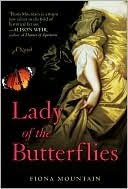LADY OF THE BUTTERFLIES
Fiona Mountain
Set in Somerset and London during the turbulent time of the Restoration, Lady of the Butterflies is a dramatic tale of passion, prejudice and death by poison, of riot and rebellion, science and superstition, madness and metamorphosis. It is also about the beauty of butterflies, about hope, transformation and redemption.
Eleanor is the daughter of a strict puritan and Roundhead major and lives in a medieval manor on the bleak wetlands of Somerset. Her longing for colour and brightness leads to an obsession with butterflies as well as to an illicit passion for charismatic but troubled Richard Glanville. Richard, the son of an exiled Cavalier, embodies all that Eleanor had been taught to despise and distrust, but he also holds for her all the allure of the forbidden. Her first husband dies, seemingly poisoned, freeing Eleanor and Richard to marry. But can their love survive suspicion and prejudice, a bloody rebellion which makes them bitter enemies, and a superstitious community that stirs up hatred towards her for her love of butterflies? It seems the only peace she can find is in her long-lasting friendship with renowned naturalist James Petiver, a clever young London apothecary who is credited as the father of British entomology. But when Eleanor and Richard’s son becomes apprenticed to James, tragedy strikes, and Eleanor is forced to embark on a dangerous search for her son that is entwined with a personal quest for truth, freedom and love.
Admittedly, I was a bit timid of this book set in the late 1600’s. Since it is not a time frame that I usually read about I was worried about not understanding things and was afraid I couldn’t make it through the 527 pages. But, I was mistaken. I fell in love with this book in the first 20 pages and if time would have allowed me, I could have read it in a few days.
I found this story fascinating and enjoyed reading about a time so different from anything I have ever known. The author described the land, the people, the homes, the clothing, nature, and the butterflies so completely and expertly that I had no trouble at all imagining the places and the people. The story involves death and grief, family, love, hardships, parenting, nature, war, and everything in between. There was joy and drama, happiness and sorrow, laughter and sadness throughout the whole story. Every chapter kept me turning the pages rapidly to see what Eleanor would say or do next. There were several characters in the story, but I didn’t have any trouble keeping them all straight. Again, the author’s descriptions and how they were introduced helped to keep everyone in your mind.
I loved all the references to God and creation in the story. The science of the 1600’s was something I had never thought of before and found all the research and sharing of knowledge very interesting. I had never thought about the great fear that science must have been those 300-400 years ago. Thank goodness for all those who blazed trails and sought the knowledge so that today we can have all the medicines and treatments we use today. I will never again look at butterflies the same.
Eleanor Glanville was the feminist of the 1600’s. When she was to be learning embroidery and her only focus was to have a “fruitful womb” she was instead reading books and studying the nature around her. She is definitely a woman to be studied and learned about and I thank the author for sharing Eleanor’s story with us.
As a mother who has gone through labor three times I found the labor and delivery process described in the most interesting. To be closed up in a room for days/weeks before and after the labor and to have numerous women from your community present at your birth was just fascinating to me. I can’t imagine having all my friends in my community sitting around my bed on stools chatting and gossipping while I am in labor screaming out in pain. After Eleanor became a mother, her struggles were much like any struggle of moms today….”If I wanted to be a good mother, I could not be a good scientist. If I wanted to be a good scientist, I could not be a good mother.” Much like the mothers today who want the career and the life of motherhood, knowing that it is a tough balance to combine the two and one will always suffer at some point.
This was such a fascinating book and one I will likely read again. Fiona Mountain obviously did her research and I am certainly glad that I am now aware of the Lady Eleanor Glanville and the Glanville Fritillary butterfly. If you would like to know more about Fiona Mountain or more information about Lady Eleanor Glanville, check out www.FionaMountain.com. I give this book 5 out of 5 stars!
This book was first published in July 2009, but has been re released and is available today, July 15, 2010. It is available on HERE.
Thanks to Putnam for sending me an ARC copy of this book. This review is 100% my own and my honest opinion. I did not receive payment for this review, just a copy of the book.
Posted Under Book Review, fiction, Fiona Mountain, historical fiction

